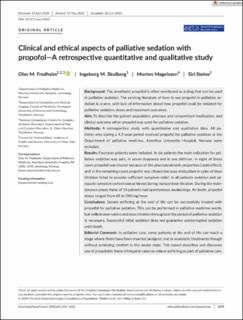| dc.contributor.author | Fredheim, Olav Magnus | |
| dc.contributor.author | Skulberg, Ingeborg M | |
| dc.contributor.author | Magelssen, Morten | |
| dc.contributor.author | Steine, Siri | |
| dc.date.accessioned | 2021-02-08T14:40:42Z | |
| dc.date.available | 2021-02-08T14:40:42Z | |
| dc.date.created | 2020-07-27T14:03:34Z | |
| dc.date.issued | 2020 | |
| dc.identifier.citation | Acta Anaesthesiologica Scandinavica. 2020, 64 (9), 1319-1326. | en_US |
| dc.identifier.issn | 0001-5172 | |
| dc.identifier.uri | https://hdl.handle.net/11250/2726669 | |
| dc.description.abstract | Background
The anesthetic propofol is often mentioned as a drug that can be used in palliative sedation. The existing literature of how to use propofol in palliative sedation is scarce, with lack of information about how propofol could be initiated for palliative sedation, doses and treatment outcomes.
Aim
To describe the patient population, previous and concomitant medication, and clinical outcome when propofol was used for palliative sedation.
Methods
A retrospective study with quantitative and qualitative data. All patients who during a 4.5‐year period received propofol for palliative sedation at the Department of palliative medicine, Akershus University Hospital, Norway were included.
Results
Fourteen patients were included. In six patients the main indication for palliative sedation was pain, in seven dyspnoea and in one delirium. In eight of these cases propofol was chosen because of the pharmacokinetic properties (rapid effect), and in the remaining cases propofol was chosen because midazolam in spite of dose titration failed to provide sufficient symptom relief. In all patients sedation and adequate symptom control was achieved during manual dose titration. During the maintenance phase three of 14 patients had spontaneous awakenings. At death, propofol doses ranged from 60 to 340 mg/hour.
Conclusions
Severe suffering at the end of life can be successfully treated with propofol for palliative sedation. This can be performed in palliative medicine wards, but skilled observation and dose titration throughout the period of palliative sedation is necessary. Successful initial sedation does not guarantee uninterrupted sedation until death. | en_US |
| dc.language.iso | eng | en_US |
| dc.publisher | John Wiley & Sons | en_US |
| dc.rights | Attribution-NonCommercial-NoDerivatives 4.0 Internasjonal | * |
| dc.rights.uri | http://creativecommons.org/licenses/by-nc-nd/4.0/deed.no | * |
| dc.title | Clinical and ethical aspects of palliative sedation with propofol—A retrospective quantitative and qualitative study | en_US |
| dc.type | Peer reviewed | en_US |
| dc.type | Journal article | en_US |
| dc.description.version | publishedVersion | en_US |
| dc.source.pagenumber | 1319-1326 | en_US |
| dc.source.volume | 64 | en_US |
| dc.source.journal | Acta Anaesthesiologica Scandinavica | en_US |
| dc.source.issue | 9 | en_US |
| dc.identifier.doi | 10.1111/aas.13665 | |
| dc.identifier.cristin | 1820623 | |
| dc.description.localcode | This is an open access article under the terms of the Creative Commons Attribution‐NonCommercial‐NoDerivs License, which permits use and distribution in any medium, provided the original work is properly cited, the use is non‐commercial and no modifications or adaptations are made. | en_US |
| cristin.ispublished | true | |
| cristin.fulltext | postprint | |
| cristin.qualitycode | 1 | |

